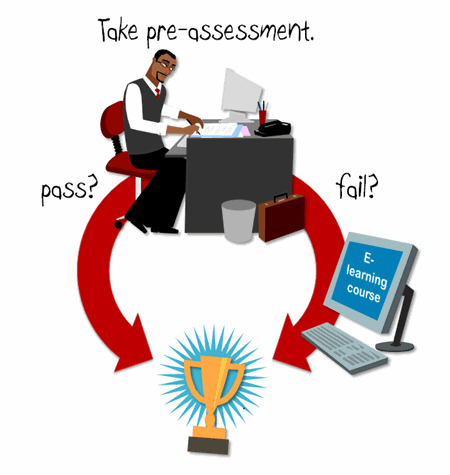[…] on http://www.articulate.com Valora esto: Me gusta:Me gustaSé el primero en decir que te gusta esta post. […]
How to Deal with Those Pesky Compliance Courses
May 22nd, 2012
I always joke about how many times I’ve had to take a course on how not to receive bribes, yet I’ve never been in a job where I was important enough to be bribed. The reason I had to take the course was because somewhere in the organization it was determined that everyone had to learn how not to get bribed whether or not it was relevant.
Most likely you’ve also had to take similar types of compliance courses. You know the drill. In November you get an email reminding you to take a list of courses before the end of the year. The subject matter may be important, but when it comes to what you do it’s usually not very relevant.
In an ideal world all elearning would be completely relevant to your job and compliance courses like this wouldn’t exist. But they do; and that’s not going to change any time soon.
So if they’re not going away, what are some things we can do to make the courses better and add more value to you and the organization?
Recognize that a compliance course isn’t usually a performance-based course.
Typically compliance courses are more like certification programs. They’re not interested in changed performance as much as they are in certifying a specific level of understanding. In that case, the process to certify can be a lot simpler than the process to teach new skills.

Do you need an elaborate role playing scenario if you just need to be reminded where to locate the fire extinguisher and emergency exits?
Don’t create a course.
Many times the compliance courses share information that is already available in other formats in the organization. If that’s the case, do you need a full multimedia product to share that information? Perhaps all you need to do is distribute a .PDF or other type of document to remind people.
If you need to do some tracking, build a simple quiz. Make the .PDF available to the elearners and then let them go online to take the quiz. The production process is a lot simpler and my guess is those who take the courses will appreciate a simpler approach.
What does the law really say?
Most compliance courses come with all sorts of constraints that aren’t conducive to good learning. For example, the course navigation is locked or there’s way too much information. When you challenge that approach to the course design, usually someone will whip out “the law says…” card.

True, there are some legal or regulatory guidelines that dictate how to build the courses for certain subject matter. But I’d spend some time to really look at what the requirements are, especially if the alternative is to build a boring and cumbersome elearning product.
In the end, you’ll still have to do what the law says. But from my experience the requirements aren’t always as draconian as first believed. And if they are, then that’s good to know.
Keep it simple.
Let’s face it; for many people compliance training is a waste of time. In those cases, make the course structure as simple as possible. Making an elearning course interactive doesn’t make it more meaningful, but it does make it more time-consuming. Sometimes all you need is five bullet points.
Interactivity is good when it fits the learner context and needs. But interactivity at the expensive of a simpler linear solution is a waste of time for the learner and the organization. So build a course that’s appropriate to the objective. If the objective is merely to have checked completion on December 31, then a linear course probably suffices and you can commit your resources to more meaningful elearning courses.
Let them test out.
I delivered an annual safety program once that had over 20 modules. Each module took 10-15 minutes. That’s up to 300 minutes of information. Multiply that by 15,000 people who had to take the course and you have over 75,000 hours of training. What does that cost the organization in lost productivity?

If you want to certify that they know the information, create a way for them to test out. Put an assessment up front to determine their level of understanding. If they can demonstrate that they know the information, why force them through the course?
Most likely you’ll still meet your compliance requirement and you’ll save the organization valuable time and resources.
Don’t lock the navigation?
The most frustrating experience in an elearning course is when the navigation is locked. I equate it to gluing all of the pages of a book together. Usually the reason we lock navigation is because we’re worried that they “won’t get all of the information.”
If you need to make sure they “got the information” then build in a mechanism so they can prove their understanding of the it. The only thing you can make sure of with locked navigation is that they visited a screen and clicked the next button when allowed to.
Reframe it so it is relevant.
While there are many compliance courses that aren’t relevant, most likely the information in the course is relevant in some way to the learner. The key is to find out how and then frame the content in a perspective that makes sense to the learner.
If you’re not quite sure how to do that, go talk to a few of them and ask how they’d use the information or where it applies to what they do. Then use their feedback as a way to reframe the content. Move it away from general compliance information and into a product that is meaningful and pertinent.
We don’t want to be cynical about compliance courses because in most cases the information is important to the organization. In an ideal world, you’ll be able to build targeted courses that are meaningful and meet the organization’s goals.
But the reality is that often the goal is an end-of-year record of completion. In those cases, it may make more sense to do a simple course to meet that goal. It’ll free up your resources and the time of the people who have to take the courses.

By the way if you do want to bribe me, I’ve been known to enjoy the Haribo Happy Colas.
Events
- Everyday. Check out the weekly training webinars to learn more about Rise, Storyline, and instructional design.
Free E-Learning Resources
 |
 |
 |
|
Want to learn more? Check out these articles and free resources in the community. |
Here’s a great job board for e-learning, instructional design, and training jobs |
Participate in the weekly e-learning challenges to sharpen your skills |
 |
 |
 |
|
Get your free PowerPoint templates and free graphics & stock images. |
Lots of cool e-learning examples to check out and find inspiration. |
Getting Started? This e-learning 101 series and the free e-books will help. |
25 responses to “How to Deal with Those Pesky Compliance Courses”
[…] How to Deal with Those Pesky Compliance Courses […]
[…] Read this article: How to Deal with Those Pesky Compliance Courses » The Rapid eLearning Blog […]
Tom,
Thanks for this. These are the majority of the elearning trainings that are created for our Blood Center. Especially since we are so very regulated by the FDA.
I go with the premise that they can test out, but have never put the quiz first. I think that is something I will try.
Thanks for this post. It was great insight and reminders for the training that is required each year. Even when it isn’t a training but a review.
Bravo! You’ve really cut to heart of the matter. This article provides some great practical advice for times when the client thinks compliance must have the same augmentations as performance-based training.
I know this is SOOOO not to the point, but can I get the cool graphics you used in the blog today? Thanks in advance!
I’ll be printing a thousand copies of this entry and randomly leaving them around the office!
As much as I love to build adaptive e-learning that shortens the seat time when learners demonstrate that they already know a topic, it’s often not an option when building compliance courseware.
Legislation is often still written which mandates a minimum seat time (California sexual harassment prevention, multiple states that mandate food safety training, etc.) Courseware developers that I’ve worked for are wary of building adaptive learning that might shorten the course to the point where it’s less than the mandated seat time. So, we lock the navigation as the course is moving forward and then we can demonstrate that it took the user at least “X hours” to complete.
Silly? Yes. It’s an easy way to legislate, though. Just make sure that everyone takes the whole course over and over again.
I’m not sure what the alternative would be, though. Could there be an approving body that rewards certification to courses that correctly validate a user’s knowledge and allows them to take a truncated course? Maybe. As a users that has to take the same aforementioned sexual harassment prevention course every two years, I wish I could demonstrate my knowledge and be done in a few minutes.
I recently had to rewrite the annual Ethics Compliance and Awareness Training for our company. We are a government contractor, so this is one of those “because we said so” annual requirements. Everyone in the company knows what Ethics Compliance means, but “training” won’t ever make anyone act ethically.
To get past the usual, boring “do this and don’t do that” training, I developed a board game for the students to play. It has a interactive spinner which returns a set value between 1 and 4. Their avatar moves that many spaces, and then a question or scenario appears. Based on their response, they are either returned to the board to spin again (correct or partially correct response), or they are penalized and moved back some number of spaces, then asked another question.
So far the response has been overwhelming positive. It doesn’t always have to be the usual “read and sign” compliance training we endured for years. A little imagination and a content manager with some leeway in how it is presented can make the boring compliance training tolerable for everyone (even the developer).
This was one of the best and most insightful posts I’ve read in a while! Thanks, Tom, for these great ideas…..this post was full of fabulous information.
Great post Tom. So often Compliance Training is not ‘Just in Time’ training but ‘Just in Case’ training. Hence being trained for something that is rarely needed. I agree that a good strategy is to ask people who will have to do the course for their thoughts. For example: to think of cases when they would need the information and base the course around that.
PS I can be bribed with a free copy of Storyline!
I like – “Let them test out”
Even better if you can use scenarios in the test, which your staff can relate to, increasing the relevance and importance of the training program. If they fail the pre-test there’ll be higher motivation to learn given they’ve realized the importance of the program during the test.
Thank you for the post. Compliance modules are always a trouble for a lot of learners, because they never have a lot to do with it, but none the less even the smallest things can roll out to a bad situation. Making a pre-assessment is a very good idea.
this is one of the most insightful post i’ve read in a while! Thanks for posting
This is an example of a course on Bullying (http://savv-e.com.au/demo/bullying_cp/main.htm). I imagine it has been designed for inclusion in a compliance training course.
I thought it was very effective. It employs a learner centred design and uses a rich multimedia format.
The outcomes are:
-Describe some of the impacts of bullying on employees and the company
-Descrivbe the different kinds of bullying
-Explain the difference between bullying and harrassment
-Describe what to do if confronted by, or witness to, bullying behaviour in the workplace.
The purpose of this course seems to be to change performance. It goes beyond certifying a specific level of understanding.
Are you suggesting that if this course is used in a compliance training course, the learner should be able to complete the ‘Assessment’ without having to complete the ‘Introduction’ or ‘Examples…’ sections? And if they don’t obtain a satisfactory mark, they can review the other sections of the course to refresh their knowledge? So the savings to the organisation are in terms of staff time. In this case the learner could complete the course in 10 mins if they only do the ‘Assessment’, instead of 19 mins if they do the whole course.
You’re not suggesting that the extra effort required to give the materials context and multimedia treatment is not warranted, just that the learner should be able to avoid doing the whole course if they are familiar with the content.
(off topic): Did you know? Haribo comes from Germany. The name stands for
HAns RIegel BOnn (Hans Riegel from the city Bonn) 🙂
I like the Happy Colas too 🙂
Greetings from Germany
David
I did an animated “infographic” for a mandatory course at my company a few years back – there was a little interactivity (mainly to keep from overcrowding the screen with a lot of “nice to know” information), but it was mostly just the “need to know” stuff pared down to bare minimum and made more interesting with statistics and visual design. I have since seen similar presentations created from our marketing department… kinda fun assuming the marketing folks were inspired by a compliance course… ;-D
Having worked in Financial Services and Call Centres, I saw a lot of stuff that was actually just a regurgitation of what was already available on a government or industry website.
This is a crazy waste of time as often (in Australia) these websites provide a summary of the key points (and some really cool graphics to illustrate the points).
The assessments then often require you to state which piece of legislation is applicable or what year it was introduced. Yep, lots of important knowledge retention in those assessments – not!
What we used to do was link to the summary website page (with the option to read the more detailed pages). We then provided real life ‘choose your own adventure’ style scenarios and assessments in relation to the job and work culture.
We also used case studies based on available material where learners had to read a case study that went to court. The case study stopped short at the outcome and they had to determine what they thought the judgement would be and the reasons why.
There’s no need to re-invent the wheel most of the time.
We also used pre-assessment quizzes at the beginning of the course too.
[…] learners. Great learning experiences can be found in many types of projects, including simple, linear courses all the way to performance-based scenarios. Knowing how and when to build the right type of course […]
Hey…I love your points on “pesky” compliance courses! BUT…when I’ve suggested the test-out option even for persons here 10 years or more, it’s received a thumbs down. So it’s full-blown e-learning instead! However, always considering what changes can be initiated, I have successfully accomplished a couple of things:
1) Created interactive e-learning rather than page-turners
2) Brought regulatory experts to the table and identified WHO needs to complete required courses. It’s allowed alot of people to opt-out altogether based upon their roles. So we didn’t even need that test-out option after all!:)
[…] A simple linear course that allows the person to get the information as fast as possible is one of the best things you can do for the organization. To make it better, you may even have the learners test out so they can avoid wasting time. […]









0
comments